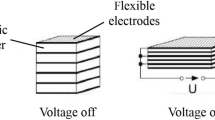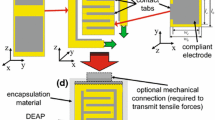Abstract
Dielectric polymer films subjected to an electric field reduce in thickness and expand in area. A pile up configuration of such films, also known as a stacked dielectric actuator, is capable of exhibiting contractive deformations while subjected to external tensile forces. This work analyzes the capabilities of the stacked actuator according to a new microscopically motivated approach which suggests that the macroscopic response is determined by four microscopic factors—the length of the polymer chains, the local behavior of the monomers, the intensity of the local dipole and the chain-density. With the aim of enhancing the actuators performance, a specific local behavior is assumed and the influence of the remaining three quantities is studied. It is shown that the actuation can be significantly improved with appropriate micro-structural changes. Interestingly, this work demonstrates that these micro-structural alterations depend on the envisaged application.








Similar content being viewed by others
References
Blythe, T., Bloor, D.: Electrical Properties of Polymers, 2nd edn. Cambridge University Press, Cambridge (2008)
Bozlar, M., Punckt, C., Korkut, S., Zhu, J., Foo, C.C., Suo, Z., Aksay, I.A.: Dielectric elastomer actuators with elastomeric electrodes. Appl. Phys. Lett. 101(9), 091907 (2012)
Cohen, N., deBotton, G.: The electromechanical response of polymer networks with long-chain molecules. Math. Mech. Solids 20(6), 721–728 (2015). doi:10.1177/1081286514550574
Cohen, N., deBotton, G.: Electromechanical interplay in deformable dielectric elastomer networks. Phys. Rev. Lett. 116, 208303 (2016). doi:10.1103/PhysRevLett.116.208303
Cohen, N., Dayal, K., deBotton, G.: Electroelasticity of polymer networks. J. Mech. Phys. Solids (2016). doi:10.1016/j.jmps.2016.03.022
Cohen, N., Menzel, A., deBotton, G.: Towards a physics-based multiscale modelling of the electro-mechanical coupling in electro-active polymers. Proc. R. Soc., Math. Phys. Eng. Sci. 472(2186), 20150712 (2016). doi:10.1098/rspa.2015.0462
Huang, C., Zhang, Q.M., deBotton, G., Bhattacharya, K.: All-organic dielectric-percolative three-component composite materials with high electromechanical response. Appl. Phys. Lett. 84, 4391–4393 (2004)
Joglekar, M.M.: An energy-based approach to extract the dynamic instability parameters of dielectric elastomer actuators. J. Appl. Mech. 81(9), 091010 (2014)
Joglekar, M.M.: Dynamic-instability parameters of dielectric elastomer actuators with equal biaxial prestress. AIAA J. 53(10), 3129–3133 (2015)
Kofod, G.: The static actuation of dielectric elastomer actuators: how does pre-stretch improve actuation? J. Phys. D, Appl. Phys. 41(21), 215405 (2008)
Kovacs, G., Düring, L.: Contractive Tension Force Stack Actuator Based on Soft Dielectric EAP. SPIE Smart Structures and Materials + Nondestructive Evaluation and Health Monitoring, p. 72870A. SPIE, Bellingham (2009)
Kovacs, G., Lochmatter, P., Wissler, M.: An arm wrestling robot driven by dielectric elastomer actuators. Smart Mater. Struct. 16(2), S306 (2007)
Kovacs, G., Düring, L., Michel, S., Terrasi, G.: Stacked dielectric elastomer actuator for tensile force transmission. Sens. Actuators A, Phys. 155(2), 299–307 (2009)
Lotz, P., Matysek, M., Schlaak, H.F.: Fabrication and application of miniaturized dielectric elastomer stack actuators. IEEE/ASME Trans. Mechatron. 16(1), 58–66 (2011)
Madsen, F.B., Daugaard, A.E., Hvilsted, S., Skov, A.L.: The current state of silicone-based dielectric elastomer transducers. Macromol. Rapid Commun. 37(5), 378–413 (2016). doi:10.1002/marc.201500576
McKay, T., O’Brien, B., Calius, E., Anderson, L.: An integrated, self-priming dielectric elastomer generator. Appl. Phys. Lett. 97, 062911 (2010)
Pelrine, R., Kornbluh, R., Pei, Q., Joseph, J.: High-speed electrically actuated elastomers with strain greater than 100 %. Science 287(5454), 836–839 (2000)
Rudykh, S., Lewinstein, A., Uner, G., deBotton, G.: Analysis of microstructural induced enhancement of electromechanical coupling in soft dielectrics. Appl. Phys. Lett. 102(15), 151905 (2013)
Shmuel, G.: Manipulating torsional motions of soft dielectric tubes. J. Appl. Phys. 117(17), 174902 (2015)
Stockmayer, W.H.: Dielectric dispersion in solutions of flexible polymers. Pure Appl. Chem. 15(539), 2816 (1967)
Suo, Z., Zhu, J.: Dielectric elastomers of interpenetrating networks. Appl. Phys. Lett. 95(23), 232909 (2009). http://scitation.aip.org/content/aip/journal/apl/95/23/10.1063/1.3272685. doi:10.1063/1.3272685
Treloar, L.R.G.: The Physics of Rubber Elasticity. Clarendon Press, Oxford (1975)
Tutcuoglu, A., Majidi, C.: Energy harvesting with stacked dielectric elastomer transducers: nonlinear theory, optimization, and linearized scaling law. Appl. Phys. Lett. 105(24), 241905 (2014). http://scitation.aip.org/content/aip/journal/apl/105/24/10.1063/1.4904473. doi:10.1063/1.4904473
Zhang, X., Lowe, C., Jahne, B., Kovacs, G.: Dielectric elastomers in actuator technology. Adv. Eng. Mater. 7(5), 361–367 (2005). doi:10.1002/adem.200500066
Zhao, X., Suo, Z.: Electromechanical instability in semicrystalline polymers. Appl. Phys. Lett. 95(3), 031904 (2009). http://scitation.aip.org/content/aip/journal/apl/95/3/10.1063/1.3186078. doi:10.1063/1.3186078
Zhao, X., Suo, Z.: Theory of dielectric elastomers capable of giant deformation of actuation. Phys. Rev. Lett. 104, 178302 (2010). doi:10.1103/PhysRevLett.104.178302
Acknowledgements
The author gratefully acknowledges G. deBotton for insightful comments and discussion.
Author information
Authors and Affiliations
Corresponding author
Rights and permissions
About this article
Cite this article
Cohen, N. Enhancing the Electro-Mechanical Response of Stacked Dielectric Actuators. J Elast 127, 103–113 (2017). https://doi.org/10.1007/s10659-016-9598-x
Received:
Published:
Issue Date:
DOI: https://doi.org/10.1007/s10659-016-9598-x




